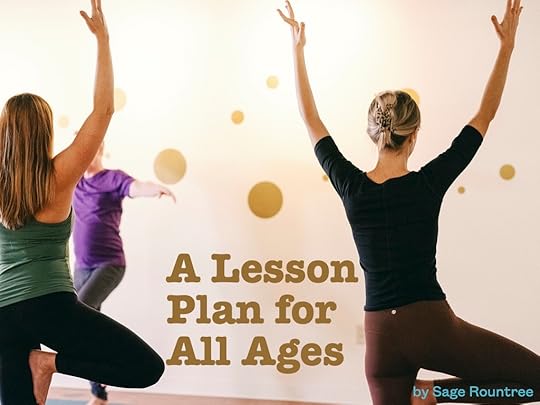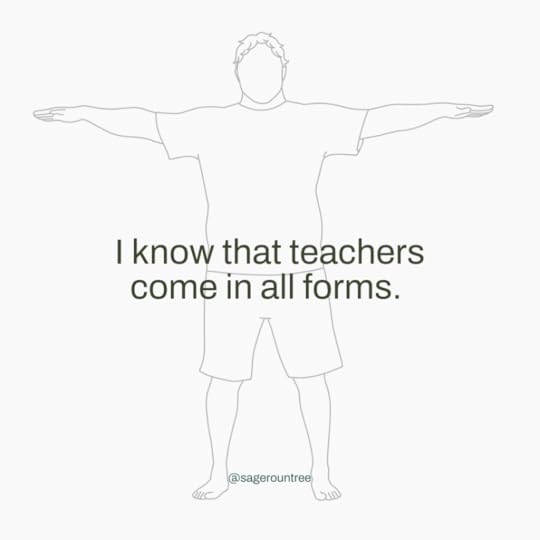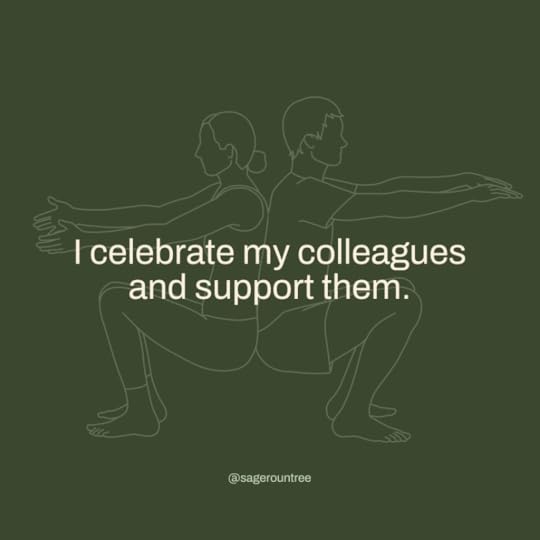Sage Rountree's Blog, page 14
September 28, 2024
Affirmation: I Trust My Students

Yoga teacher affirmation: I trust my students to express their unique selves through their poses.
I do not have X-ray vision. I trust my students are doing what is best for them. I can’t see what’s going on in their skeletons, and I can’t see what’s going on in their hearts and minds.
I offer choices and celebrate my students’ expression of their unique selves.
The post Affirmation: I Trust My Students appeared first on Sage Rountree.
September 26, 2024
Preorder Available: Teaching Yoga Beyond the Poses, Vol. 2
Now available for preorder wherever books are sold: Teaching Yoga Beyond the Poses, Volume 2.
preorder nowMany tens of thousands of yoga teachers have used Teaching Yoga Beyond the Poses to inspire their students and introduce helpful yoga lessons in their yoga classes.
This new volume 2 isn’t a second edition—it’s a whole-new book, with 54 fresh themes, an evolved theming template, and all our best advice for taking your students beyond the poses and toward the heart of yoga: union and connection.
Look at this gorgeous cover!

Alexandra and I can’t wait to get this book into your hands in March 2025! You can preorder now at your favorite bookstore or right here:
preorder nowlet me plan your next class
Feeling uninspired when it’s time to plan? I’m here to help!
Give me your email and I’ll send you my go-to class plan with ideas for every minute. This is the class I teach when my energy is low—but it’s the favorite of my students from 20 to 80 years old! I’ll even give you tips on how to adapt it for various class formats.
The post Preorder Available: Teaching Yoga Beyond the Poses, Vol. 2 appeared first on Sage Rountree.
September 24, 2024
How to Get Better at Teaching Yoga: Be an Ongoing Student
Great yoga teachers are also great students. Attend classes regularly to keep your practice fresh and your teaching sharp. Learn from others, stay curious, and let your students benefit from your continuous growth.
Yoga teachers: if you want to become almost everyone’s favorite teacher, I encourage you to go to class as a student this week and every week! Not only is it good for your student-hood, it will make you a better teacher.
Take classes with a teacher’s ear—listen for what works and what doesn’t. Stay attuned to the choices, both conscious and unconscious, that your teachers make when you are in the classroom. Feel your way through transitions that are useful; notice how it feels and how the room looks when something doesn’t land. Set up in different parts of the room to see what the student experience is like there. The view from the back and the front could be vastly different; being closer to the door or window or farther from it may affect the student experience a lot.
It’s especially useful to be a student in the very classroom(s) where you teach, so you can notice things that you won’t see when you’re teaching. Strive to have the same experience your students have, down to using the studio-issued mat. You may find that your hands slip in downward-facing dog or your knees need some extra cushioning in tabletop, and these observations can translate into creating a more positive experience for your students when you offer modifications in your next class.
Make note of anything that works particularly well, and consider how you would do things differently when things don’t work well. It can help to put this down on paper or to write it down immediately after class. For example, my don’ts would be having the music too quiet (I find this a distraction), shining bright light in students’ eyes, and not telling students what to expect in the course of the class.
let me plan your next class
Feeling uninspired when it’s time to plan? I’m here to help!
Give me your email and I’ll send you my go-to class plan with ideas for every minute. This is the class I teach when my energy is low—but it’s the favorite of my students from 20 to 80 years old! I’ll even give you tips on how to adapt it for various class formats.
The post How to Get Better at Teaching Yoga: Be an Ongoing Student appeared first on Sage Rountree.
September 21, 2024
Affirmation: I Know That Teachers Come in All Forms

Yoga teacher affirmation: I know that teachers come in all forms.
I know every being has something to teach me: human/nonhuman, in and out of yoga, all ages, all shapes, all colors. Each opportunity to connect is a chance for growth.
I welcome teachers in any form.
The post Affirmation: I Know That Teachers Come in All Forms appeared first on Sage Rountree.
September 19, 2024
Coming October 15: Yoga Teacher Confidential Podcast
Meet Yoga Teacher Confidential, a podcast designed for yoga teachers seeking to build confidence and expertise. Starting October 15, each episode will bring you practical advice, personal stories (some juicy!), and professional insights aimed at making your teaching journey smoother and more fulfilling.
I’ve been having such fun planning, recording, and producing this podcast!
In my college and graduate school days, I spent six years as an announcer and engineer on public radio, a period over which the technology changed from reel-to-reel tape machines to digital audio recorders.
I had a podcast, Sage Yoga Training, in the first wave of podcasting in the aughties. (If you’ve been following my work for a long time, you might remember it was a follow-along voice-guided short yoga practice with a slideshow illustration.) Back then, getting an RSS feed up and running was extremely difficult.
It’s been a total blast to take advantage of the easy means available now. I can’t wait to share these stories and secrets with you!
Subscribe wherever you get your podcasts.
Here’s a trailer to whet your appetite:
To stay in the loop as episodes drop, sign up for my teachers’ newsletter:
let me plan your next class
Feeling uninspired when it’s time to plan? I’m here to help!
Give me your email and I’ll send you my go-to class plan with ideas for every minute. This is the class I teach when my energy is low—but it’s the favorite of my students from 20 to 80 years old! I’ll even give you tips on how to adapt it for various class formats.
The post Coming October 15: Yoga Teacher Confidential Podcast appeared first on Sage Rountree.
September 17, 2024
How to Get Better at Teaching Yoga: Define Yourself
What kind of yoga teacher do you want to be? Drill sergeant, sassy best friend, or something else? Defining your teaching persona helps you align your classes with your vision and goals.
Yoga teachers: what’s your teaching persona? Drill sergeant? Sassy best friend? Something else?
It can be helpful to articulate what kind of teacher you want to be, so that you have a goal to be striving toward, and to know when you are meeting your vision for yourself as a teacher. Periodic redefinition or reinforcement of your goals will keep you on track.
Here’s a self-inquiry prompt to get you started. Begin by noting what you think your own teachers do well. Write a little about:
+ the tone your teachers use with students in class and out of class
+ the body language and physical reaction your teachers use with students in class and out of class
+ the interactions you see your teachers use with students in class and out of class, including on social media if relevant
Next, write a description of the kind of teacher you want to be. Notice any friction between how you want to act and how you feel you have been acting.
Finally, given what you know about your students and the content of the class, write a little about the right tone for the class. Is it drill sergeant? Sympathetic coach? Caring mother figure? Sassy best friend? Repeat for each of the classes in your schedule—they could be different. When you review recordings of your class, be sure to check whether the tone you hear matches the tone you meant to convey.
You can get this and many other workbook exercises keyed to my book The Professional Yoga Teacher’s Handbook right here!
GET THE WORKBOOK AND IMPROVElet me plan your next class
Feeling uninspired when it’s time to plan? I’m here to help!
Give me your email and I’ll send you my go-to class plan with ideas for every minute. This is the class I teach when my energy is low—but it’s the favorite of my students from 20 to 80 years old! I’ll even give you tips on how to adapt it for various class formats.
The post How to Get Better at Teaching Yoga: Define Yourself appeared first on Sage Rountree.
September 14, 2024
Affirmation: I Have a Sense of Humor

Yoga teacher affirmation: I have a sense of humor—it’s only yoga.
Flubbing my words, forgetting a side, falling out of a pose, farting—stuff happens in class. It’s OK, it’s only yoga.
If at the end of class, people feel better, it was a win.
The post Affirmation: I Have a Sense of Humor appeared first on Sage Rountree.
September 10, 2024
How to Get Better at Teaching Yoga: Use the One Tool You’re Holding
Want to get better at teaching yoga? Use the tool in your hand—record yourself during class and watch the video. It’s a game-changer for identifying areas of improvement.
https://youtu.be/lhbCFcgnidUYoga teachers: there’s one really quick way to get better RIGHT away, and it uses the very tool you’re probably holding right now.
It’s to record yourself and watch the video!
I suggest you do this every few months. Here’s how.
First, record yourself during a real class. This doesn’t have to be a professional-grade video; even five minutes captured on your phone will teach you loads. Be sure you let your students know that you are doing this solely for your self-improvement, and angle the camera so that your students aren’t on-screen—or obtain their permission before including them in the shot.
Once you’ve got the recording take a few deep breaths, settle down, and watch it. Here’s what to do:
Number 1. Be alone. Watch the video and allow yourself all the cringing you want. If your experience is like mine, you’ll think, in quick succession: “Do I really look like that?!?” “Do I really sound like that?!?” and “When did I turn into my mother?!?” (To be clear, in my case, that’s a good thing, if a little shocking.)
Number 2. Start over. Look for the good. Pinpoint at least three things you did well.
Number 3. Start over again. Listen for the filler. Hear your go-to words, and determine which could be cut. If you don’t hear any, try transcribing your own video, which will likely make them jump out. Even five minutes of typing a transcription will show you what could go. You will very quickly type and see every extraneous word. Even ten minutes of this task will help you immensely.
Number 4. Start over yet again. Use a timer to gauge whether you are offering a similar duration of hold on both sides of asymmetrical poses, and listen to hear whether you give students express permission to stay longer or move out of a pose early. If you like, follow along with the class and see how it feels.
Number 5. Repeat this exercise, making a new recording and reviewing it, again at regular intervals. Aim to do it a few times each year. It’s painful, I know, but self-review with video is one of the quickest tools to make you the best teacher you can be.
let me plan your next class
Feeling uninspired when it’s time to plan? I’m here to help!
Give me your email and I’ll send you my go-to class plan with ideas for every minute. This is the class I teach when my energy is low—but it’s the favorite of my students from 20 to 80 years old! I’ll even give you tips on how to adapt it for various class formats.
The post How to Get Better at Teaching Yoga: Use the One Tool You’re Holding appeared first on Sage Rountree.
September 7, 2024
Affirmation: I Celebrate My Colleagues

Affirmation: I celebrate my colleagues and support them.
I go to my colleagues’ classes and welcome them in mine. I recognize the value of studenthood, and the power of community. I trust there are enough students for all of us to help, and I know we are on the same team.
The post Affirmation: I Celebrate My Colleagues appeared first on Sage Rountree.
September 3, 2024
How to Get Better at Teaching Yoga: Journal Reflections
Self-reflection is a powerful tool for growth. After each class, take a few moments to jot down what worked, what didn’t, and what surprised you. These insights will guide you toward becoming a better teacher, class by class.
https://youtu.be/n8lZqkyQ6AkMuch of the development you’ll see as a teacher comes in tiny, incremental pieces, week to week, as you reflect on your previous class and plan for the next one.
Have you heard of a “hostess diary”? It’s an old-fashioned device to record a personal debrief after throwing a party. (You can find some cute ones on Amazon or at fancy stationery stores.) The great hostesses make notes after each party. What was the theme or occasion of the party? What was served, who sat where, what was discussed? What could be changed for next time?
The same practice works well for yoga teachers. As soon as is feasible after class, and no later than the next day, take some notes of your own in your journal or notes file. Here’s a journal prompt for you. And I suggest you do this after every class—it doesn’t need to take long at all.
Make notes on your last class. What did you plan? What went well? What surprised you? Was there any deviation from your plan, and if so, why? How did it land? What did not go well? If it works for you, you can list these as roses (the pros), thorns (the cons), and buds (things to build on next time).
If you wrote out a class plan ahead of time, either on paper or, better yet, on your computer, this could simply be another column or section in the notes, including the date and your reflections on what happened. And I suggest you do plan ahead of time! For an easy method, see The Art of Yoga Sequencing or join me for Plan a Month in an Hour, my regular lesson-planning co-working session.
let me plan your next class
Feeling uninspired when it’s time to plan? I’m here to help!
Give me your email and I’ll send you my go-to class plan with ideas for every minute. This is the class I teach when my energy is low—but it’s the favorite of my students from 20 to 80 years old! I’ll even give you tips on how to adapt it for various class formats.
The post How to Get Better at Teaching Yoga: Journal Reflections appeared first on Sage Rountree.



